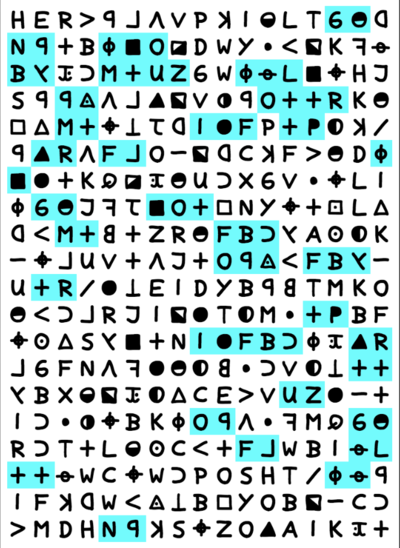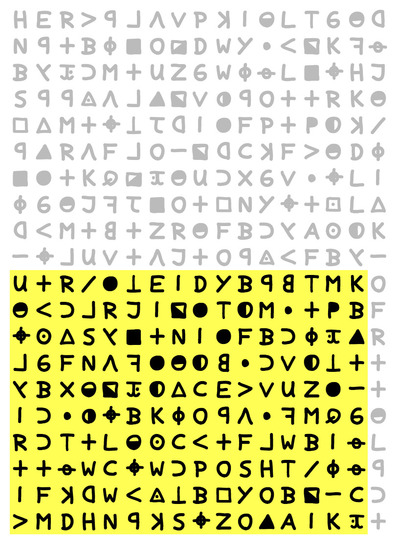Thanks for testing that, smokie. Good information to have.
Maybe you guys noticed this before:
We know that the lower left of Z340 has very few bigrams:

But if you extract the highlighted rectangle, and delete everything else:

There are zero repeated bigrams whatsoever.
In shuffles, I found this to be a -2.15 sigma observation, seeing 0 repeats there in about 1 in 100 shuffles. So not THAT strong. But kind of curious.
there are certain plain text words in the cipher that i posted about on my thread that are obvious upon close examination. possibly the reason for your increase in randomization. being that they are probably excluded from the main cipher. what i think he did was he had 2 cryptic messages in one. once i highlighted the words in the body of the z340 we can clearly see we are left with quite a few character that might also have a deeper meaning.
Maybe you guys noticed this before:
We know that the lower left of Z340 has very few bigrams:
But if you extract the highlighted rectangle, and delete everything else:
There are zero repeated bigrams whatsoever.
In shuffles, I found this to be a -2.15 sigma observation, seeing 0 repeats there in about 1 in 100 shuffles. So not THAT strong. But kind of curious.
Very interesting…
Seems to reinforce the idea that the 340 was enciphered in a unique multi-step process and/or by regions, with some type of rotation or inversion in the lower left part.
This also (at least to me) seems to validate the authorship of the letters.
I have doubts that a copycat would be able to include such telling hints so shortly after the release of the 340, considering we are still finding out things about it almost 50 years later.
The + symbol on row 13 just like hinted at in the letter and the most defined Zodiac symbol in the right spot, with the area of low bigrams coinciding with the rotated text of the letter…

enlarge
I am not really qualified to post on this thread but had a thought. Has anyone tested how the 340 responds by cutting the last 4 columns off so that it’s a 13×20 grid? It’s evident the number 13 does surface quite a bit. In the drippining pen letter he writes on the right side…”and i can’t do a thing with it.” You guys have probably already tried but thought I’d throw it out there.
Klaus Schmeh made an interesting post about a series of ads from the 1930s with decipherment challenges:
http://scienceblogs.de/klausis-krypto-k … asure-hunt
Someone solved one of them and it turned out that the plaintext was written into the two main diagonals, followed by the remaining spaces.
Thomas,
Following up on your initial break of #3 (AOWNWESTSD…), I find that writing the cryptogram into a 10 X 10 square, then first reading the two diagonals (upper left to lower right, then upper right to lower left), followed by the remaining letters in each of the ten lines, gives:
“A sure-footed man can go down west side of Devil’s Canyon above Falls. Map is in bottle at base of cedar tree. Wear rubber soles.”
I thought it was an interesting mix of transpositions. Jarlve, I wonder how your solver would treat it. Would it solve the main parts (everything but the diagonals) since they would dominate the statistics? Could the partial transposition along the diagonals be detected?
Would it solve the main parts (everything but the diagonals) since they would dominate the statistics? Could the partial transposition along the diagonals be detected?
No, the horizontals are thoroughly interrupted by the diagonals in the 10 by 10 square. It has no support for such transposition schemes.
1 21 22 23 24 25 26 27 28 11 29 2 30 31 32 33 34 35 12 36 37 38 3 39 40 41 42 13 43 44 45 46 47 4 48 49 14 50 51 52 53 54 55 56 5 15 57 58 59 60 61 62 63 64 16 6 65 66 67 68 69 70 71 17 72 73 7 74 75 76 77 78 18 79 80 81 82 8 83 84 85 19 86 87 88 89 90 91 9 92 20 93 94 95 96 97 98 99 100 10
This is really an interesting transposition and exactly what I meant by "interlocked ciphers" a few postings before:
For the moment I will focus my further efforts in a different direction. I try to look as little as possible at statistics and prefer creative transpositions or interlocked encryption instead. I have found some other, quite simple possibilities that cannot be solved by the AZDecrypt transposition solver. Perhaps this will also help in favouring other points of view.
AZDecrypt is extremely strong in solving combinations of transposition/substitution. However, there are also many creative transpositions that cannot be solved automatically. So it’s not unlikely that z340 will use any kind of creative transposition. But how are we going to find out? An automatic solver may not help (at least I don’t know how). And simply guessing can lead to the goal, but the probability is extremely low. Even statistics can put us on the wrong track.
Let’s take Doranchak’s linked transposition again. Maybe we should try this:
1 – Create an 18×18 plain text
2 – Transpose this as shown in the link above
3 – Now first substitute the two diagonals
4 – Then substitute the remaining characters
(Step 3 and 4 either with the same key or with two different keys)
I haven’t tried it yet, but I wouldn’t be surprised if you see a bigramm peak at Period other than 1. Even if not, it at least explains the interrupted cycles.
To make it clear: I am not saying that z340 is based on this transposition, but it is a very good example.
Translated with http://www.DeepL.com/Translator
This is really an interesting transposition and exactly what I meant by "interlocked ciphers" a few postings before:
For the moment I will focus my further efforts in a different direction. I try to look as little as possible at statistics and prefer creative transpositions or interlocked encryption instead. I have found some other, quite simple possibilities that cannot be solved by the AZDecrypt transposition solver. Perhaps this will also help in favouring other points of view.
AZDecrypt is extremely strong in solving combinations of transposition/substitution. However, there are also many creative transpositions that cannot be solved automatically. So it’s not unlikely that z340 will use any kind of creative transposition. But how are we going to find out? An automatic solver may not help (at least I don’t know how). And simply guessing can lead to the goal, but the probability is extremely low. Even statistics can put us on the wrong track.
Let’s take Doranchak’s linked transposition again. Maybe we should try this:
1 – Create an 18×18 plain text
2 – Transpose this as shown in the link above
3 – Now first substitute the two diagonals
4 – Then substitute the remaining characters(Step 3 and 4 either with the same key or with two different keys)
I haven’t tried it yet, but I wouldn’t be surprised if you see a bigramm peak at Period other than 1. Even if not, it at least explains the interrupted cycles.
To make it clear: I am not saying that z340 is based on this transposition, but it is a very good example.Translated with http://www.DeepL.com/Translator
1. Transpose the plaintext
2. Encode most of the plaintext LRTB perfect cycles
3. Encode the rest of the plaintext by some other pattern perfect cycles
Or maybe step 3 before step 2
= interrupted cycles
Interesting idea and it could be done very simply with pencil and paper by someone not necessarily interested in making the cryptogram more difficult to solve, knowing about the transposition, but by someone maybe just getting creative or entertaining himself, or, maybe thinking that it would make solving more difficult.
Transposition by matrix, and encoding by another matrix that results in high cycle scores LRTB but not perfect cycles.
I am wondering how to detect an encoding matrix. Look at each most high scoring cycle, and locate the symbol that interrupts the cycle, and find a pattern that is the same for some of these cycles?
Interesting idea and it could be done very simply with pencil and paper by someone not necessarily interested in making the cryptogram more difficult to solve, knowing about the transposition, but by someone maybe just getting creative or entertaining himself, or, maybe thinking that it would make solving more difficult.
I totally agree. I still do not exclude the possibility that we have thought too complicated so far. I don’t know if the term "interlocked cipher" is appropriate, but for lack of a better knowledge of English I will leave it at that for now.
Such interlocked ciphers are, as you have just said, very easy to generate with pen and paper. Moreover, many of them cannot be solved with the methods we are currently using. I wouldn’t be surprised if these kinds of ciphers produce the funniest statistics pointing in the completely wrong direction. Currently I’m working on another project and let z340 rest for a while. Maybe I will try out how interlocked ciphers affect periodic bigram bias or pivots. The pivots and the 24 plus symbols, which seem to be grouped around the middle (source:Jarlve), could maybe also be explained in this way.
But now I’m starting to speculate too much, which is something I like to do. Here is a quote from Ludwig Wittgenstein:
"Eine Hypothese ist ein Gesetz zur Bildung von Erwartungen."
The English translation is something like: "An hypothesis is a law for forming expectations"
Translated with http://www.DeepL.com/Translator

